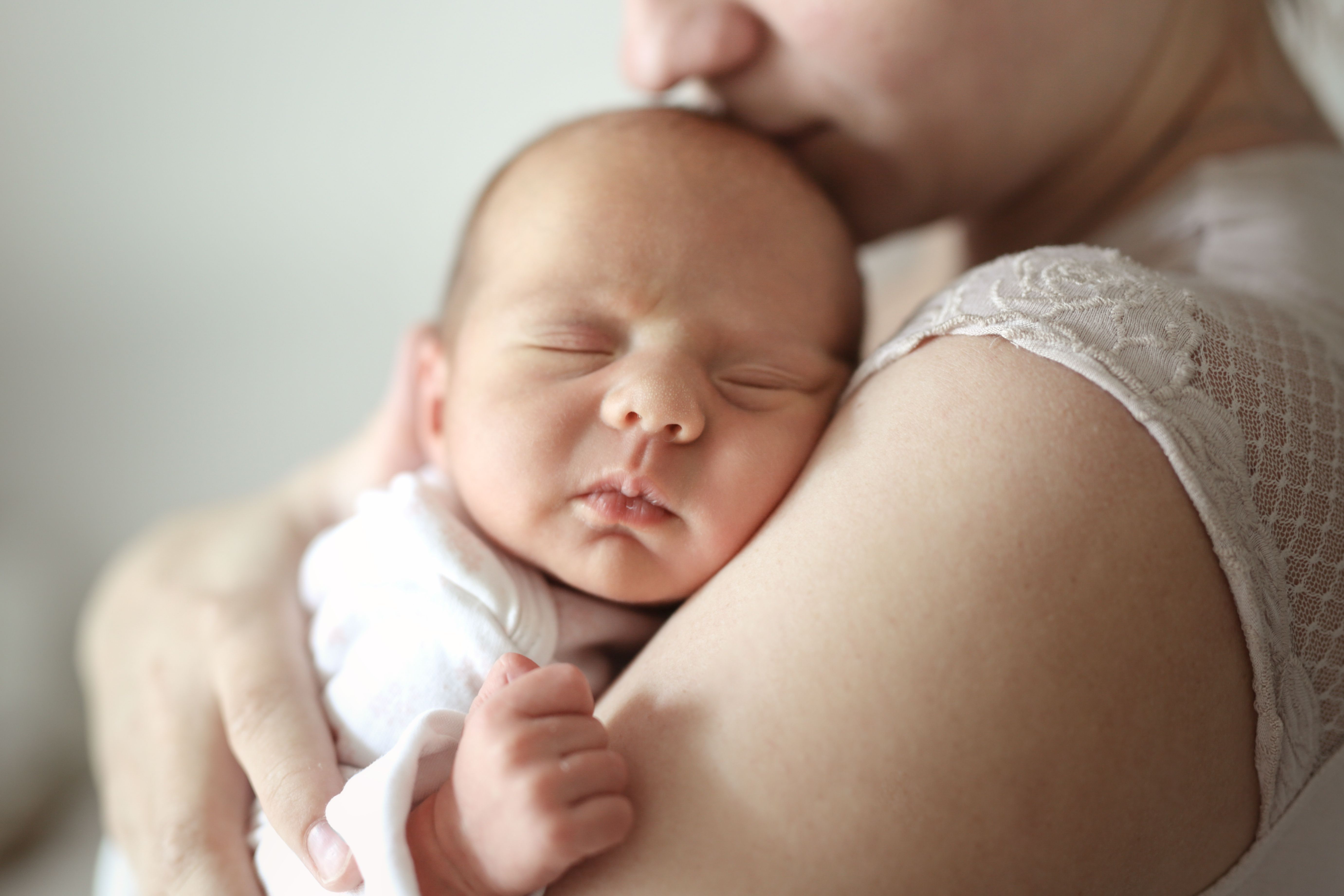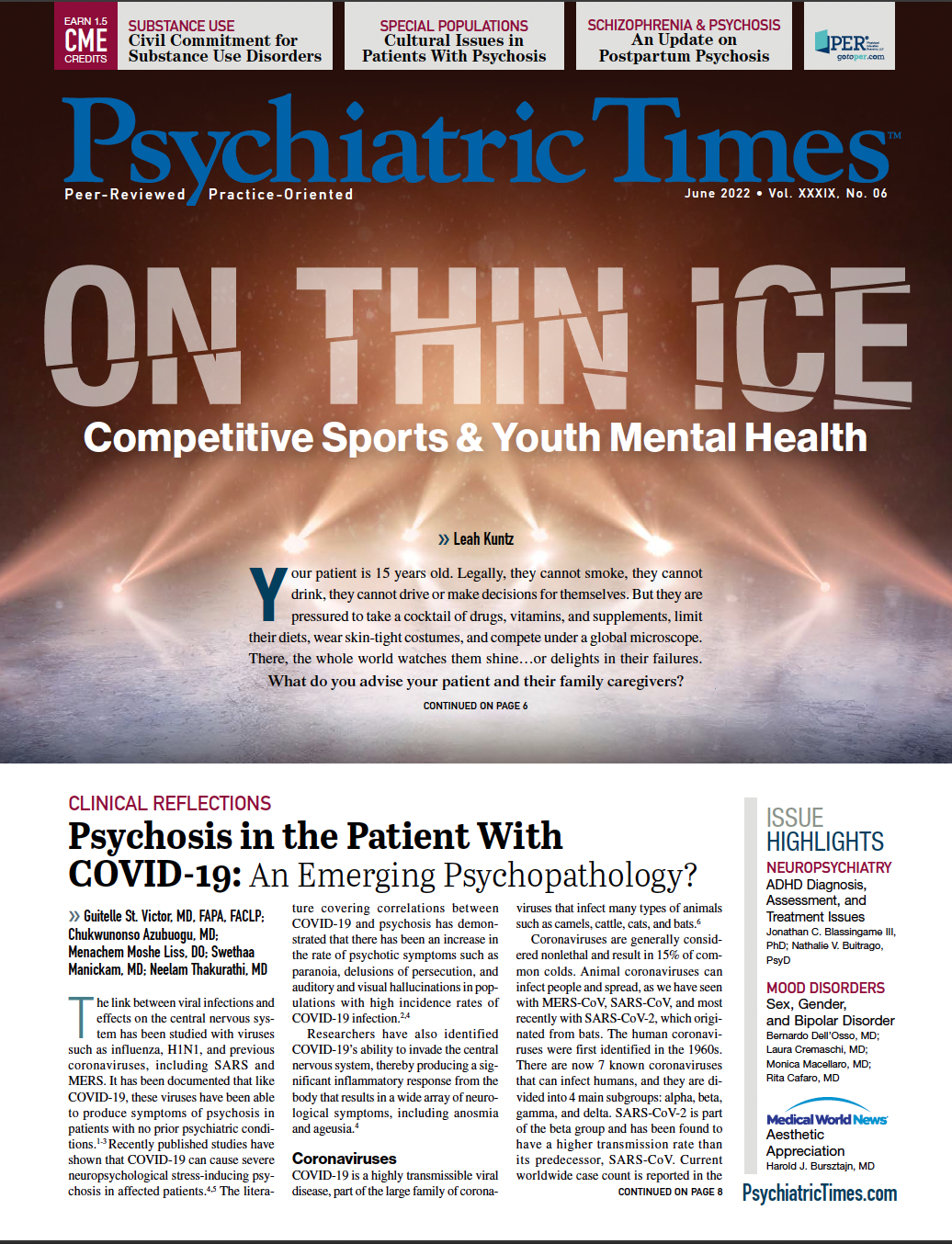Publication
Article
Psychiatric Times
Motherhood and the 4 Symptom Domains of Borderline Personality Disorder
Author(s):
Borderline personality disorder is a common diagnosis among young women that is highly understudied in pregnancy and motherhood. Learn more here.
natalialeb/AdobeStock

Women adapting to their new roles as mothers can struggle with substantial mental health challenges. Postpartum depression, for example, is widely understood as the most common condition faced by mothers after delivery. However, mothers can face many other overlooked psychiatric challenges across pregnancy, the postpartum period, and motherhood. Borderline personality disorder (BPD) is a common diagnosis among young women that is highly understudied in pregnancy and motherhood.
Prevalence of BPD in the general population may be as high as 5.9%, around 10% in psychiatric outpatient clinics, and around 20% among psychiatric inpatients.1,2 BPD is overwhelmingly diagnosed in women; around 87% of those receiving diagnoses are female. It is also thought to be associated with a higher degree of disability in women.1 Average age upon diagnosis is 24.8 years. Delayed diagnosis is common, often happening after an average of 3.6 years of treatment.3
“Motherhood” is a broad construct involving constant change: pregnancy, postpartum, infancy, toddlerhood, school-age children, teenager, empty-nesting. We can consider 4 main domains of symptoms within BPD: identity/sense of self, impulsivity, relationship difficulties, and affective instability.
In the United States, the mean age of women at first birth is 26.9 years, which closely corresponds to the average age of women upon BPD diagnosis.4 By age 44 years, 85% of women in the United States have had at least 1 biological child, with an average of 2.1 children per woman.5 Based on these data, women with BPD are statistically likely to become mothers.
BPD is linked to challenges in pregnancy. In women with BPD, symptom severity has been associated with teenage pregnancy, unplanned pregnancy, and multiple prenatal adverse events.6
In one study, women with BPD who presented for delivery were more likely to have used nicotine or other addictive substances during pregnancy.7 Women with BPD have shown overall low rates of adherence to prenatal care and overall high likelihood of experiencing pregnancy as traumatic.8
Women with BPD have also been found to be at substantially higher risk of preterm delivery than women in a hospitalwide control group; their infants were more likely to have low Apgar scores.8 During the postpartum period, 23.1% of women seeking psychiatric inpatient admission to a mother-baby unit in Australia met criteria for BPD.8 Another 11.1% showed significant BPD features without meeting full diagnostic criteria.8
There have been substantially higher rates of reports made to child protective services—and a high rate of substantiation for those reports—for women with BPD compared with women without BPD.9 Another study found that persistent high levels of comorbid depression in the mother across the first year postpartum was associated with externalizing problems in children when measured at 2.5 years postpartum,10 but this link was entirely associated with the presence of BPD symptoms in the mother.
Clinically, we see substantial symptom variability among women as they navigate motherhood, with some symptoms improving and others worsening. Although there is very little research addressing these symptom shifts directly, we can synthesize what we know from the literature and draw on clinical experience to examine how these symptoms are likely to change across the span of motherhood.
Sense of Self
Personal identity is conceptualized through role commitments, a sense of inner agency, a world view that gives life meaning, and continuity across time. Motherhood has a profound impact on sense of self and can lead to a reevaluation of how autonomy, physical appearance, sexuality, and occupations influence these identities differently than they did prior to motherhood.11
Shifts in how mothers understand themselves in relationship to others often begin with pregnancy.12 Socioculturally, intensive pressure is placed on mothers in Western societies to adopt “intensive parenting” practices that can squeeze out other important aspects of identity outside of motherhood.13 Cultural portrayals of motherhood emphasize fusion of a mother with her baby as the goal and the expectation.14
In women with BPD, there are often clinical improvements in patients’ sense of self and a reduction in their experience of internal emptiness in their new role as mother. However, this initial stabilization is often brief. As children begin the process of individuation, mothers with BPD may experience it as a threat to their own sense of self, with subsequent heightened distress and symptomatology.15 There is also an increase in distress for these mothers as their grown children leave home, with substantial challenges in reestablishing a sense of self independent of the role they played as a mother caring for children living at home.
Impulsivity
Impulsivity has a known negative impact on pregnancy. It is associated with a higher risk of unplanned pregnancy, risky sexual behaviors, and a risk for sexual victimization.16-18
There is limited evidence that impulsivity increases during pregnancy and the postpartum period, although this notion is very understudied.19 Impulsivity in individuals with BPD commonly manifests in substance use disorders, with as many as 57% of individuals with BPD experiencing a comorbid substance use disorder.20 The negative impacts of substance use in pregnancy have been well documented.
Impulsivity is also associated with safety concerns, such as self-injurious behavior and risk for suicide.21,22 Impulsivity is also associated with eating, particularly binge eating, which can impact the health of women and their babies during pregnancy as well as body image during the postpartum period.
Evidence suggests that across the life span, impulsivity tends to become a less common symptom in BPD. However, certain kinds of impulsivity may increase during times of distress, and it is unclear how impulsivity changes in pregnancy and the postpartum period.23,24 For women in general, studies point to lower rates of self-harm during pregnancy.25
Relationship Difficulties
The development of healthy relationships requires “theory of mind,” or the ability to understand our own internal state and that of others. Theory of mind includes cognitive and affective components, to understand others’ thoughts/beliefs and emotional states.26,27
Connected regions of the brain that are active when we exercise this ability are referred to as the “theory of mind network.”28 Mothers make use of this ability, as they coregulate affect, when their baby is distressed and they mirror the baby’s distress to facilitate soothing.
During pregnancy, women experience changes in their brain architecture that likely strengthen their ability to care for and raise a child.29 These involve changes within the theory of mind network and have been shown to predict mother-baby attachment postpartum.30 These changes have the potential to impact women’s relationships with their larger community; their ability to draw support from their communities is associated with resilience to postpartum distress, whereas low support is a consistent risk factor in postpartum distress.31,32 Relationship distress, with increased conflict intensity, is common after the birth of children and women who lack support from a partner have a higher risk of developing and maintaining postpartum depression.33
Relationships are particularly challenging for women with BPD. Adults with BPD have been shown to have significant deficits in theory of mind and often struggle to cooperate with others as a relationship progresses and to repair following a rupture in cooperation.34,35
This makes women with BPD particularly vulnerable during the transition to motherhood and the postpartum period, when the ability to draw support from relationships is critical to maternal well-being. It also affects a mother’s ability to develop secure attachment with her baby, which is critical to child development. However, there is hope that the brain-based changes of motherhood might mitigate some of this risk or lend improvement in these areas.
Affective Instability
Functional neuroimaging studies of patients with BPD have shown frontolimbic dysfunction that has a differential impact on negative emotionality and is consistent with clinical challenges around affective lability seen in adults with BPD.36
Women with BPD struggle more with mood shifts in response to hormone fluctuations; that is, changes in ovarian hormone levels have been associated with fluctuations in negative emotionality and impulsivity in women with BPD. Fluctuations in hormone levels also characterize pregnancy and parturition, which may indicate that there is an increased risk in women with BPD for mood changes and symptom exacerbation during this period compared with women without BPD.37,38
Concluding Thoughts
BPD traits vary individually over time and core traits of BPD can carry additional risk for distress as women transition to motherhood and parent young children. Additional research is needed to further understand the model of pathology for women with BPD as they enter motherhood and to determine strategies that can lead to resilience and health for mothers and their families.
Dr Netherton is a psychiatrist and regional medical director with Mindpath Health. Dr Rohr is director of women’s mental health at Houston Methodist Hospital in Texas.
References
1. Grant BF, Chou SP, Goldstein RB, et al. Prevalence, correlates, disability, and comorbidity of DSM-IV borderline personality disorder: results from the Wave 2 National Epidemiologic Survey on Alcohol and Related Conditions. J Clin Psychiatry. 2008;69(4):533-545.
2. Korzekwa MI, Dell PF, Links PS, et al. Estimating the prevalence of borderline personality disorder in psychiatric outpatients using a two-phase procedure. Compr Psychiatry. 2008;49(4):380-386.
3. Kjaer JN, Biskin R, Vestergaard C, et al. The clinical trajectory of patients with borderline personality disorder. Personal Ment Health. 2016;10(3):181-190.
4. Births and natality. CDC. Updated February 16, 2022. Accessed March 30, 2022. https://www.cdc.gov/nchs/fastats/births.htm
5. Martinez G, Daniels K, Chandra A. Fertility of men and women aged 15-44 years in the United States: National Survey of Family Growth, 2006-2010. Natl Health Stat Report. 2012;(51):1-28.
6. De Genna NM, Feske U, Larkby C, et al. Pregnancies, abortions, and births among women with and without borderline personality disorder. Womens Health Issues. 2012;22(4):e371-e377.
7. Pare-Miron V, Czuzoj-Shulman N, Oddy L, et al. Effect of borderline personality disorder on obstetrical and neonatal outcomes. Womens Health Issues. 2016;26(2):190-195.
8. Blankley G, Galbally M, Snellen M, et al. Borderline personality disorder in the perinatal period: early infant and maternal outcomes. Australas Psychiatry. 2015;23(6):688-692.
9. Yelland C, Girke T, Tottman C, Williams AS. Clinical characteristics and mental health outcomes for women admitted to an Australian mother–baby unit: a focus on borderline personality disorder and emotional dysregulation? Australas Psychiatry. 2015;23(6):683-687.
10. Huntley F, Wright N, Pickles A, et al. Maternal mental health and child problem behaviours: disentangling the role of depression and borderline personality dysfunction. BJPsych Open. 2017;3(6):300-305.
11. Nicolson P. Loss, happiness and postpartum depression: the ultimate paradox. Can Psychol. 1999;40(2):162-178.
12. Steinberg Z. Donning the mask of motherhood: a defensive strategy, a developmental search. Stud Gend Sex. 2005;6(2):173-198.
13. Ishizuka P. Social class, gender, and contemporary parenting standards in the United States: evidence from a national survey experiment. Soc Forces. 2019;98(1):31-58.
14. Douglas S, Michaels M. The Mommy Myth: The Idealization of Motherhood and How It Has Undermined All Women. Simon and Schuster; 2005.
15. Aidane É, Wendland J, Rabain D, Marie P. Un suivi thérapeutique atypique: co-constructions thérapeutiques de la relation précoce d’une mère borderline et son bébé. Psychiatr Enfant. 2009;52(1):131-166.
16. Godiwala P, Appelhans BM, Moore Simas TA, et al. Pregnancy intentionality in relation to non-planning impulsivity. J Psychosom Obstet Gynaecol. 2016;37(4):130-136.
17. Dir AL, Coskunpinar A, Cyders MA. A meta-analytic review of the relationship between adolescent risky sexual behavior and impulsivity across gender, age, and race. Clin Psychol Rev. 2014;34(7):551-562.
18. Holcomb BM, Mahoney CT, Lawyer SR. Impulsivity and sexual assault. In: O’Donohue WT, Schewe PA, eds. Handbook of Sexual Assault and Sexual Assault Prevention. Springer; 2019:369-380.
19. Altın GE. Impulsivity during pregnancy and the postpartum period. Psychiatry Clin Psychopharmacol. 2018;28:353-354.
20. Trull TJ, Sher KJ, Minks-Brown C, et al. Borderline personality disorder and substance use disorders: a review and integration. Clin Psychol Rev. 2000;20(2):235-253.
21. Herpertz S, Sass H, Favazza A. Impulsivity in self-mutilative behavior: psychometric and biological findings. J Psychiatr Res. 1997;31(4):451-465.
22. Maser JD, Akiskal HS, Schettler P, et al. Can temperament identify affectively ill patients who engage in lethal or near-lethal suicidal behavior? A 14-year prospective study. Suicide Life Threat Behav. 2002;32(1):10-32.
23. Videler AC, Hutsebaut J, Schulkens JEM, et al. A life span perspective on borderline personality disorder. Curr Psychiatry Rep. 2019;21(7):51.
24. Cyders MA, Smith GT. Mood-based rash action and its components: positive and negative urgency. Pers Individ Differ. 2007;43(4):839-850.
25. Mota NP, Chartier M, Ekuma O, et al. Mental disorders and suicide attempts in the pregnancy and postpartum periods compared with non-pregnancy: a population-based study. Can J Psychiatry. 2019;64(7):482-491.
26. O’Neill A, D’Souza A, Samson AC, et al. Dysregulation between emotion and theory of mind networks in borderline personality disorder. Psychiatry Res. 2015;231(1):25-32.
27. Harari H, Shamay-Tsoory SG, Ravid M, Levkovitz Y. Double dissociation between cognitive and affective empathy in borderline personality disorder. Psychiatry Res. 2010;175(3):277-279.
28. Schurz M, Radua J, Aichhorn M, et al. Fractionating theory of mind: a meta-analysis of functional brain imaging studies. Neurosci Biobehav Rev. 2014;42:9-34.
29. Anderson MV, Rutherford MD. Cognitive reorganization during pregnancy and the postpartum period: an evolutionary perspective. Evol Psychol. 2012;10(4):659-687.
30. Hoekzema E, Barba-Müller E, Pozzobon C, et al. Pregnancy leads to long-lasting changes in human brain structure. Nat Neurosci. 2017;20(2):287-296.
31. Yeh ZT. Role of theory of mind and executive function in explaining social intelligence: a structural equation modeling approach. Aging Ment Health. 2013;17(5):527-534.
32. Lowe SR, Chan CS, Rhodes JE. Pre-hurricane perceived social support protects against psychological distress: a longitudinal analysis of low-income mothers. J Consult Clin Psychol. 2010;78(4):551-560.
33. Biaggi A, Conroy S, Pawlby S, Pariante CM. Identifying the women at risk of antenatal anxiety and depression: a systematic review. J Affect Disord. 2016;191:62-77.
34. Németh N, Mátrai P, Hegyi P, et al. Theory of mind disturbances in borderline personality disorder: a meta-analysis. Psychiatry Res. 2018;270:143-153.
35. King-Casas B, Sharp C, Lomax-Bream L, et al. The rupture and repair of cooperation in borderline personality disorder. Science. 2008;321(5890):806-810.
36. Salavert J, Gasol M, Vieta E, et al. Fronto-limbic dysfunction in borderline personality disorder: a 18F-FDG positron emission tomography study. J Affect Disord. 2011;131(1-3):260-267.
37. Eisenlohr-Moul TA, Schmalenberger KM, Owens SA, et al. Perimenstrual exacerbation of symptoms in borderline personality disorder: evidence from multilevel models and the Carolina Premenstrual Assessment Scoring System. Psychol Med. 2018;48(12):2085-2095.
38. Peters JR, Eisenlohr-Moul TA. Ovarian hormones as a source of fluctuating biological vulnerability in borderline personality disorder. Curr Psychiatry Rep. 2019;21(11):109. ❒







